














































When the Canadian Architect Awards of Excellence began in 1967, there were few architecture awards in Canada. The Massey Medals, which later became the Governor General’s Medals in Architecture, started in 1950, and a scattering of other awards recognized exemplary built works.
Fifty-five years later, that picture has changed dramatically: according to research led by scholars from the Université de Montréal, Concordia, and McGill, there are now over 70 organizations in Canada offering awards in the built environment. This increase in the number of organizations offering awards is mostly a North American phenomenon, notes lead researcher Jean-Pierre Chupin. Globally, individual awards organizations have gone from offering an average of a dozen awards each in the 1960s to some 100 awards each now.
Adding to the complexity of the awards landscape is a shift in procurement criteria, in which many clients are now requesting lists of awards. This comes from a good-faith attempt to value architectural quality in their selection processes—although it also points to the awkwardness of squaring the often qualitative measure of what constitutes “good architecture” with the quantitative metrics and scorecards of standard procurement practices.
On one hand, this has resulted in a field day for “pay-to-play” awards programs, which thrive on receiving large numbers of entries— and in turn, delivering large numbers of accolades. On the other hand, many organizations whose reputations are tied to high-quality awards are going though a soul-searching exercise.

What are the right criteria for awards today?

What do awards ultimately value?


The Canadian Architect Awards occupy a unique place in this field, since they focus on future projects—ones that are in design and construction phases, rather than fully realized. Recognizing the possibility for aspirations to remain more intact at this stage, several years ago we layered social equity and environmental sustainability into the evaluation criteria. Two years ago, we also began asking for energy performance models, where available.
As co-chair of the RAIC ’s Awards Advisory Committee, I’ve also been involved in an ongoing process of revisiting the Institute’s awards. Part of this work has involved streamlining offerings, in order to present a more concise slate of awards. Within the renewed awards, there is a recognition of the changing nature of the profession and of the discipline. The RAIC Research and

Innovation Award, for instance, has been expanded to recognize not just technological innovations, but new modes of practice and the important work being done in academic teaching and research, including in areas such as diversity, equity, inclusion and decolonization.
Questions around the fundamental value of awards were also at the heart of discussions at the Prairie Design Awards, for which I was a juror this fall, alongside architects Bruce Kuwabara, D’Arcy Jones, Lola Sheppard, photographer James Brittain, and landscape architect Mark van der Zalm. Including a professional photographer on the jury gave perspective to the reliance of built environment awards on photographic images, which, as Brittain noted, have increasingly adhered to a set of standard conventions. An alternative model can be seen in municipal design awards, where jurors visit a shortlist of projects in-person. At an international level, the Aga Khan Awards for Architecture delegates a panel of technical reviewers to each project, who collect detailed information and interview building clients and occupants to report back to the jury.
The Prairie Design Awards jury also asked: How can awards programs take a more critical approach to questions of Indigeneity, social equity, and environmental accountability? The current mandate of the program is to “recognize innovation and design excellence,” but is this enough? “We need a sea change, and people know exactly what I’m talking about, because they feel the responsibility to do something,” said Bruce Kuwabara at a panel discussion following the awards presentation. “The criteria for what I thought constituted excellence in architecture—all the fundamentals—have shifted. The awards are great, but the challenge is bigger than the awards.”
“Awards programs bear witness to the transformation needed in architecture and the design disciplines, and given their visibility as standard-bearers for ‘design excellence’, efforts must be made to set out awards criteria accordingly, said Prairie Design Awards moderator Eduard Epp. How we respond to calls for social equity, environmental sustainability, de-colonization, and accessibility—aligning them with the conventional measures of beauty, commodity, and delight—has a value beyond awards. Such values, says Epp, “speak directly to the questions of professional agency and accountability to society and to the planet.”
We have elevated the standard for privacy in metal partitions. ASI’s partitions are engineered with built-in privacy and manufactured as one color matched unit. The result?





A patent-pending design with superior aesthetics and complete privacy without the need for any retrofitted components. Exactly what building occupants want and deserve.


At ASI privacy isn’t an afterthought—it’s our standard. Visit asi-globalpartitions.com/privacy







THERE’S ONLY ONE METAL PARTITION WHERE PRIVACY IS TRULY INTEGRATED. INTRODUCING ASI’S PROPRIETARY, INTEGRATED PRIVACY ™ SYSTEM FOR METAL PARTITIONS.





In October, jurors Peter Hargraves, Betsy Williamson, Louis Lemay, and photo juror Félix Michaud met to adjudicate the 55th annual Canadian Architect Awards of Excellence. They considered 153 professional entries, 30 student entries, and 31 photo entries to arrive at their selection of winners.

What is architecture’s role amidst pressing issues such as surging inflation, the growing magnitude of the climate crisis, and an increasing awareness of the need for greater social equity? Many of these issues come together in the calls for reconciliation with Turtle Island’s

Indigenous Peoples, a notion reflected in the large number of submissions received that addressed Indigenous clients, or bore Indigenous names. From among these, the jury selected two projects to be recognized with awards. The Mukwa Waakaa’igan Indigenous Centre of Cultural Excellence at Algoma University, by Moriyama & Teshima Architects with Smoke Architecture, adjoins a former residential school building. It offers a compelling architectural response to the question of how to handle buildings with a fraught history; there is an ongoing search for unmarked burials on the site. The new intervention does not seek to destroy or overcome the existing colonial structure, but instead aims to to create a place of knowledge-sharing and healing, through a curved, mass timber building that gently rises to look over the former residential school towards new futures.
Another awarded building, the Muscowpetung Powwow Arbour, is a place of celebration a centre for the summer powwow celebrations that take place for the Muscowpetung First Nation, located in southern Saskatchewan. Designed by Oxbow Architecture and Richard Kroeker. The structure draws inspiration from the form of Prairie teepees, and points to the importance of the circle in Indigenous cultures. Moreover, it looks to the Indigenous ingenuity used to craft structures from the resources at hand: the pavilion is built from local trees milled on-site, and uses light, tension connections that minimize the materials used. The result is a delightful building, and a case study in how non-Indigenous architects and designers can engage with Indigenous communities in thoughtful ways to create a meaningful result.
Although the project did not win an award, the jurors were impressed by the robust community consultation with many Indigenous organizations that was part of the process for designing the Dawes Road Library in Toronto, by Smoke Architecture with Perkins & Will.


The resulting design a boldly patterned, softly curved façade evoking a blanket wrapping the building is one they felt could only legitimately emerge from the direct involvement of an Indigenous designer and from extensive consultation. To bring this to the next level, they would have liked to see the same process more deeply inform the interior planning and design of the space.

A consultative community process a tendency that the jurors feel will accelerate over the coming years was also at the heart of another project that was noted by the jury, but did not win an award. In Hope Blooms: Community, Design, Build, Halifax-based firm FBM engaged in a co-creation process leading to the design of a series of flexible modular booths that could be deployed to support a park’s pop-up market, urban garden, and performance area. While the end result did not have the same degree of complexity as the selected projects, the jury admired the community engagement that underpinned the work.
Environmental sustainability was another theme of note in this year’s submissions. Over a third of the entries were accompanied by an energy report, and the metrics for many buildings were encouraging generally tracking well under 100 kwh/m2/year for Total Energy Use Intensity (TEUI), and in some cases targeting a Thermal Energy Demand Intensity (TEDI) of less than 20 kwh/m2/year. One project recognized by the jury, Passive(doppler)haus in Search of the Sublime, by EDGZ Architecture & Design Studio, is a Toronto infill dwelling with a TEDI of a mere 14.6 kmh/m2/year and a TEUI of 60 kwh/m2/year a demand fulfilled in part by photovoltaic panels, set on a rooftop angled to optimize their placement. The jury was impressed by how these energy achievements were taken in stride, contributing, rather than detracting from, a layout that creates careful sight lines and displays a judicious consideration of materials within a compact layout of duplex units.
























































Significant savings in embodied carbon are realized through the adaptive reuse of existing buildings. This is one of several themes in the design of PHI Contemporary, by the consortium of Pelletier de Fontenay, Kuehn Malvezzi, and Jodoin Lamarre Pratte, which the jury selected for an award. Located on a site in Old Montreal, the design deftly weaves together several existing structures with a series of galleries, courtyards, and terraces, inviting a variety of contemporary artistic interventions. The jury also appreciated the Court House Theatre in Saint John, New Brunswick, by EXP Architects, as an elegant adaptive reuse and addition on a tight urban site, which appropriately converts a former courtroom into a stage. Another round of design refinement, they felt, may have edged the project into award territory.

Several of the awarded projects were notable for their attunement to their context. The Montreal Holocaust Museum, by KPMB Architects and Daoust Lestage Lizotte Stecker Architecture, reflects the rhythm of its St. Laurent Boulevard site, evoking the lots of storefronts in the neighbourhood once at the heart of the city’s Jewish community. Another pair of projects in Montreal pay homage to different aspects of the city. Coeur Nomade Library and Cultural Centre, by Affleck de la Riva and Coarchitecture, is a study in culturally attuned architecture that creates a warm, welcoming space for new immigrants and residents alike in a lower-income sector of Montreal. Les Ateliers Angus, by NÓS , nestles a dozen studios for craftspeople in the shell of an old railway manufacturing facility.
How does this kind of contextual thinking translate to a larger scale? The jury saw positive direction in a project located near the Angus site. Canoë, by Aedifica and ADHOC architectes, is a masterplan for a new residential block that draws on the typology of Montreal’s laneways to create a vibrant, pedestrian-oriented central spine.
While not awarded, the jury also saw a confluence between issues of sustainability and affordable housing in the project for 1925 Victoria Park, in Toronto, by PARTISANS . The project imagines a path


forward for rental housing in the city through the use of modular mass timber frames, which create a street-facing cellular structure for apartments and retail storefronts, and a courtyard activated with exterior balconies and terrace planting.

The elusive combination of craft and contextual senstivity was seen in two final projects awarded by the jury. Drawing on the log-clad vernacular of local buildings from the 1960s, the Hornby Island Arts Centre, by D’Arcy Jones Architects, creates a flexible space for artistic pres-
entations and gatherings in a community off the coast of Vancouver Island. And in Edmonton, gh3* and S2 Architecture’s Blatchford District Energy Sharing System Sewage Heat Exchange tackles a valuable approach to heat recovery with technical prowess, refined architectural form, and a touch of humour.
This year’s student awards went to a trio of projects that took diverse approaches, showcasing the range of research and design thinking currently emerging from architectural education. Johnathan Lum’s Chaos & Control looks at the how to design structures that help restore land and habitat in a compromised ecosytem, using felled cottonwood trees that are generally overlooked as a construction material. Jon Ackerley’s Subindustria is also interested in the delicate balance between humans and the natural environment, but takes a contrasting approach, with a graphics-centric proposal for a somewhat dystopian future, where suburban houses become components in an industrial machine for producing more of their like, from bio-based materials grown and processed on site. Naomi Julien’s From Loom to Room experiments with using string to weave a one-person room, exploring the possibilities of working with a single, ephemeral material to delineate space.
Five years ago, Canadian Architect introduced the Photo Awards of Excellence to recognize the artistic presentation of completed works of architecture. This year, photographer James Brittain won recognition for images of an old building a Dory Shop in Nova Scotia, one in a series of vernacular buildings he documented for architect Brian MacKay-Lyons and a new building the Montreal Insectarium, by Kuehn Malvezzi, Pelletier De Fontenay, and Jodoin Lamarre Pratte architects. Jacqueline Young was similarly recognized for two photographs: an atmospheric image of an apartment tower wrapped Christo-like in white building paper, under a blanket of snow, and a golden
• Carleton’s Co-op program makes it easy to recruit exceptional talent.

• 150+ programs to choose from, including Architecture, Civil Engineering, Architectural Conservation and Sustainability Engineering, and more.
• Students are available for year-round hiring to suit your recruitment schedule. Carleton co-op students bring the knowledge, skills, and fresh insight needed to help your business thrive in today’s fast-paced, technology-driven society.
For more information, visit carleton.ca/employers.
hour image of a builder at work on a small riverside hut. Finally, Lisa Stinner-Kun’s image captures a group of elk, framed in the breezeway of a lakeside house by 1x1 Architecture.
Where does landscape end, and architecture begin? Who are the clients of the buildings in these images, who are the designers, and who are the builders? In which cases are they one and the same? It’s a rich ambiguity, at the heart of many of the winning projects in the pages of this issue.

Connectivity to the natural environment.

Since 1994, Bison Innovative Products has led the industry in designing and manufacturing versatile pedestals, pavers, and site furnishings that offer the design exibility to create unique and beautiful rooftop environments. Our independently tested, modular deck system allows rooftop decks to be installed quickly and easily.

Peter Hargraves MAA, MRAIC



Peter Hargraves leads the team at Sputnik Architecture. He brings with him a wealth of experience which has been gained over 20 years working in large North American centres including Portland, Toronto, Montreal, and for the past decade, Winnipeg. He has completed projects that vary from health care and education facilities, to housing and community services. In 2009, Peter launched Sputnik Architecture with the ambition of establishing a small practice that would use art and architecture to generate public interest in matters of civic importance. A great lover of winter, Hargraves used the opportunity presented by winter in Winnipeg to explore ways of igniting the imaginations of citizens, establishing the annual Warming Huts program in 2010. The program brings local, national, and international creators together to create pavilions on a series of skate trails in downtown Winnipeg each winter. This year, Warming Huts won the 2022 RAIC International Prize. Under Hargraves’ direction, Sputnik Architecture has developed a solid reputation for creativity, hard work, and dedication to client satisfaction.


Louis T. Lemay Architect, FRAIC, AIA Louis T. Lemay is CEO and excellence facilitator at Lemay. Throughout his practice, he has dedicated himself to the creation of groundbreaking architecture that creates long-lasting value through sustainability and promotes the well-being of its users. His work is guided by a strong belief in the power of creating spaces
bisonip.com | 800.333.4234
centered on the wellness and health of the communities they serve. The firm’s transdisciplinary work has been recognized with national and international awards, including recognition at the Royal Architectural Institute of Canada’s Awards of Excellence, the Architecture Masterprize, Canadian Architect’s Awards of Excellence, and the Governor General’s Medals in Architecture.
A leader and mentor in his field, his focus today is turned toward ensuring the carbon neutrality of the built environments his firm designs, and using his expertise to help shape a more equitable, inclusive, diverse and just world for future generations. He is a committed contributor to the business community and a wide range of charities, devoting resources to serve both the environment and underrepresented communities at home and abroad. He is chair of the Fondation David Chiasson, a board member of the Fondation Yvon Lamarre, and governor for the Grande campagne des Carabins de l’Université de Montréal.

Betsy Williamson is a principal in the architectural design studio Williamson Williamson, an office committed to using both built and unbuilt work as vehicles to explore diverse research and design agendas. Her office’s work has been published widely and has received numerous awards over the years. Notable practice-based recognition includes the Professional Prix de Rome for Architecture from the Canada Council of the Arts, the Emerging Architectural Practice Award from the Royal Architectural Institute of Canada, and the Young Architects Prize and the Emerging Voices Award from the Architectural League of New York.
Betsy serves as vice-chair of the Waterfront Toronto Design Review Panel, actively contributing to a culture of quality at an urban scale by signalling that design excellence is a critical consideration for the development of Toronto’s waterfront. Betsy is also a dedicated advocate for equality in the profession. With a group of like-minded architects, she founded and professionally advises BEAT (Building Equality in Architecture Toronto). BEAT is dedicated to the promotion of equality by creating events and web content for the advancement of women in the profession, and by providing mentorship, networking and leadership opportunities.

Joining the other jurors for the Canadian Architect Photo Awards of Excellence deliberations, Félix Michaud specializes in architectural and interior design photography that exhibits a sensitivity to space. Through his Montreal-based practice, he seeks to build on architectural concepts by offering an intimate interpretation of the places he photographs. His work alternates between commissioned work and personal projects, and his images are regularly published. Recently, he won the 2021 Canadian Architect Photo Award of Excellence and was the 2022 Architecture A+ Awards Public Choice winner in the Architecture + Photography and Video category. His series Experience of Space Valerio Olgati was a finalist in the 2020 A+ Awards. His work also exhibits an interest in black-and-white photography and medium-format film. Michaud has been active in photography since 2005 and is a graduate of Cégep de Matane.
Toronto Community Housing is pleased to announce that we are moving to a quality-based selection process for the public procurement of architectural and engineering consulting services.
We are seeking innovative architectural firms to work with collaboratively to preserve and renew our portfolio assets, raise the quality of design services, and act as partners to greatly enhance occupant comfort and improve the quality of tenant lives. Visit torontohousing.ca/vendors and see RFVQ 22051 for more information.

Cliff Youdale, Chief Development Officer, Ottawa Community Housing
| Ottawa
While designing new affordable housing units for families, seniors and couples to Passive House Standard, Ottawa Community Housing collaborated with sustainable building experts from the Savings by Design program to optimize energy performance, build better than code and earn financial incentives.†


gh3* works in the increasingly complex realm where architecture, urbanism and landscape overlap. We design with a modernist’s eye to order, beauty, and social possibility, and an environmentalist’s awareness of sustainability and long-term thinking.
We have completed projects at every scale, from small park pavilions to large civic and transit infrastructure, and recently, Canada’s first natural swimming pool. Our energetic and interdisciplinary team is committed to the best in creative practice. We bring a tailored, client-centred approach to every stage of the design and construction process, with the aim of achieving pragmatic, poetic, environmentally responsible, and aesthetically powerful design solutions. We believe that excellent design is an essential part of everyday life, and that spatially and visually engaging places can inspire joy and civic pride.
S2 Architecture provides full service architectural, interior design, and master planning services across Western Canada. We take pride in our collaborative and inclusive approach to create spaces for people that support well-being, cultivate community, and uphold sustainable design.




Our 30-year history includes work across a broad range of building and project types, and the foundation of our success is deeply rooted in the value we place on our relationships with our clients, our consultants, our employees, and our teammates. With studios in Calgary, Edmonton, and Vancouver, S2 is committed to shaping the built environment of our communities collaboratively, creatively, and sustainably. Our team brings energy, passion and a spirit of togetherness to every project.

Moriyama & Teshima Architects is a team of architects, planners and designers collaborating with visionary clients to build inspiring and enduring spaces that transform communities and reinforce civic identity.


The office’s extensive portfolio of Canadian and international projects comprises museums and art galleries, university buildings, schools, faith-based spaces, corporate and government headquarters, recreational facilities, libraries, restoration and renovation projects, and urban/ campus planning.


Under the current leadership, Moriyama & Teshima Architects has cultivated a dynamic team of young, innovative designers around a long-standing core of design traditions that continue to define our practice. Our studio is made up of individuals who reflect the cultural diversity that defines our global present: a combination of industry leaders and young designers working together to design and deliver exceptional projects.

We believe that the success of design is rooted in collaborative processes that approach challenges and solutions holistically, and that work at all times to integrate site, building, context and a plurality of perspectives into a built reality of which we can all be proud.


Smoke Architecture is Anishinaabeg-owned and operated. Providing complete architectural services since 2014, we focus on First Nation and Indigenous projects. Our clients, guided by Elders and community leaders, hold millennia of expertise on how and what to build in our traditional territories; Smoke Architecture exists to support their success.

Our design process is guided by and responsible to our clients. The path we take rediscovers Indigenous knowledge in contemporary contexts. This process of land-based learning applies to each project we undertake, using engagement tools, design techniques, and building systems crafted specifically for each community and each place.

Give your next design something special. Kingspan insulated metal panels empower your vision with exceptional design flexibility, efficiency and outstanding thermal, air, water and vapor barrier performance for the ultimate building envelope solution.


Kuehn Malvezzi was founded by
Kuehn

Johannes Kuehn in Berlin in 2001. Public spaces and museums are a main focus of their practice, with projects including the reorganization of the art collection at the Belvedere in Vienna, the extension of the Friedrich Christian Flick Collection at the Hamburger Bahnhof – Museum for Contemporary Art in Berlin, the Modern Gallery at the Saarland Museum and the Julia Stoschek Collection in Düsseldorf. Most recently, the firm won the international competition for the redesign of the Bâtiment d’Art Contemporain in Geneva.










Oxbow Architecture bridges Saskatchewan’s two major urban centres, Regina and Saskatoon. As a studio, we are committed to advancing the depth and quality of design in our home province and beyond. Our collective built work, public engagement, dedicated research and sessional appointments at the University of Manitoba, Dalhousie University, and Saskatchewan Polytechnic exemplify our dedication to serving our clients, communities and the next generation of design leaders.

Our studios are based in Saskatchewan on Treaty 6 and Treaty 4 Territories. We are proud to be a part of this land and acknowledge that it is current and ancestral home of the Metis, Nēhiyawak/Plains Cree, Nehithaw/Woodland Cree, Néhinaw/ Swampy Cree, Dakhóta/Dakota, Lakhóta/Lakhóta/Lakota, Nakota/ Stoney, Anishinaabe/Nahkawe/Saulteaux, Asiniibwaan/ Assiniboine, and Dene First Nations.
Richard Kroeker is Professor Emeritus at Dalhousie University, where he has taught for many years, and served as acting Director. Richard has Prairie roots: he is a graduate of the University of Manitoba Environmental Studies program, and later, the Architectural Association in London, U.K., where he registered as an architect as well as practised. His design practice has garnered both international and local awards. Richard’s current research and practice focus on design in the context of communities and cultures at risk.
Their work also focuses on sustainability and building with an awareness of social contexts and nature, such as in the Oberhausen office building on a complex inner-city site, and the Lot Petit - ZAC SaintVincent-de-Paul in the 14th district of Paris.




Prizes and awards include nominations for the Mies van der Rohe Award and becoming finalists for the DAM Prize for Architecture in Germany. Kuehn Malvezzi’s work has been shown at venues including the Venice Biennial, Manifesta 7, the Chicago Architecture Biennial and the Lisbon Architecture Triennale.




Getting the right finishes installed in the 151 suites of a four-star Marriott hotel in Burlington, Ontario required great care in selecting the right setting materials. MAPEI had everything The Pearle Hotel & Spa needed, with products locally sourced for fast-track installation.



Tiling in wet areas was set using MAPEI Ultralite ® Mortar , which features BioBlock ® technology for mold and mildew resistance. Elsewhere, tiles for other interior floors were installed using Ultraflex ® LFT ™ premium large-and-heavy-tile mortar. All these tiles were grouted with Ultracolor ® Plus FA , which was chosen for its exceptional aesthetic quality and its proven ability to maintain color consistency and inhibit efflorescence for ease of maintenance.
For more information, visit www.mapei.ca or call 1-800-42-MAPEI (1-800-426-2734).
 Photos by: Carole & Roy Timm Photography
Photos by: Carole & Roy Timm Photography
Montreal-based Pelletier de Fontenay was established in 2010 by Hubert Pelletier and Yves de Fontenay. The office has quickly gained a reputation for excellence in designing contemporary public buildings and is currently working on projects for museums, schools and libraries.
Pelletier de Fontenay won international competitions for the Losbates school near Prague, the Montreal Insectarium (in partnership with Kuehn Malvezzi and Jodoin Lamarre Pratte architectes), and provincial competitions for Lab-École Shefford and the Sanaaq community center in downtown Montreal. They have been recognized by major prizes including the Architectural League prize for emerging architects.
The studio is particularly interested in the relationship between abstract concepts in architecture and their material embodiments. This approach is deepened by an involvement in teaching and research. Parallel to their practice, Pelletier de Fontenay’s research initiatives include the Invariations project, an abstract creative exploration of the fundamental principles of architecture, and Architectures de la Nature Captive, a project examining the relationship between the built and the living.
Founded in 1995 by Gavin Affleck and Richard de la Riva, Montrealbased Affleck de la Riva Architects believes that quality environmental design is an agent of social change and a key element in fostering citizenship, social equity, and healthy lifestyles. The firm provides services for the design and construction of institutional, cultural, and residential projects and has also developed specific expertise in urban design and the restoration of historic structures.
For almost thirty years, through a wide range and scale of projects including research, competitions, and built work, Affleck de la Riva has been exploring the potential of history and landscape to generate contemporary architecture. An interest in the craft-based traditions of noble materials has led to a number of building restoration commissions, including several important historic monuments. One cannot build contemporary architecture without assimilating the lessons of the past.
The quality of Affleck de la Riva’s work has been recognized by international publications from countries including France, England, United States, Spain, China, Romania, South Korea, and Turkey, and invitations to lecture in Europe and across North America. The firm is the recipient of more than twenty professional distinctions including first prize awards in four architectural competitions, a Governor’s General Medal in Architecture, three Awards of Excellence from the Order of Architects of Quebec, and a Canadian Architect Award of Excellence.
Gavin Affleck and Richard de la Riva are active members of Canada’s architectural community. They have taught at schools of architecture across the country and contributed to numerous committees and organizations.


Coarchitecture was formed in 2011 as a relaunch of the firm Les Architectes Hudon et Julien, founded in 1976. Building on this solid base, Coarchitecture developed a new conceptual approach to their projects grounded in integrated design and sustainable development. Today, the firm employs 60 professionals with artistic, scientific, and technical expertise that contributes to the creation of spaces whose vitality goes beyond form and matter. The Coarchitecture team creates environments that are innovative, engaging and avant-garde.
For Coarchitecture, success is measured by the positive impact our projects bring to the lives of users. Each project is imbued with an evergrowing desire to take ideas further and to create a unique experience. Placing collaboration at the heart of its creative approach, Coarchitecture
Jodoin Lamarre Pratte architectes devotes its practice to the design of architectural projects in healthcare, transportation, education, research and culture, as well as the realization of large corporate and governmental projects. The firm works towards the conception of a human, sensitive, intelligent architecture that respects its environment, combining creativity, knowledge and innovation. It values the diversity and complementarity of the skills and expertise of the members of its large team and perpetuates a culture of collaboration, inclusion, integrity and thoroughness.
Sustainability manifests itself holistically in all aspects of their buildings, including flexibility of use, durability of systems, overall energy performance, minimizing the ecological footprint of materials, creating quality living environments, integrating buildings with their environment, and creating resilience to climate change.
The 125-person firm is the recipient of 160 awards of excellence and distinctions in architecture, attesting to its abilities to consistently design and build projects of high architectural quality.
fashions tailor-made environments that carefully meet clients’ needs.

Supported by building science, Coarchitecture’s design approach focuses on innovation for sustainable development. The Canadian Green Building Council has mandated our firm to provide training on the LEED -v4 system and we hold more than 21 LEED certifications, including five Gold and one LEED -v4.


Established in Montreal in 1985, Ædifica approaches architecture with an emphasis on collaboration, social equity, agility, and resilience. These principles are carried through the way we work in-concert with clients, adjacent services, and relevant partners. This approach aims to enrich and nurture the lives of those who experience the environments we are honoured to design and build.
We work with sustainability strategists, engineers, urban designers, and interior designers, in a holistic context that places great value on creativity and experimentation within our process. We believe that architecture’s purpose is to help communities prosper over the long term through resilient, environmentally integrated designs. This belief, combined with our natural sense of curiosity, contributes to architecture acting as a foundational pillar in our organization’s pursuit of its mission: to enrich human lives by creating sustainable, carbon-neutral, and inspiring places.
Founded in 2016 by Gil Hardy and Charles Laurence Proulx, NÓS is an emerging architecture and urban design office that envisions each commission as an opportunity to design a unique environment. Working in a collaborative spirit and involving the community in the creative process, the firm brings together designers and experienced professionals with proven know-how supporting bold visions for the contemporary city.
NÓS’s practice ranges from tactical public realm interventions to largescale architecture projects and urban design schemes. The firm’s interest in artistic experimentation has led it to contribute to cultural works such as Moving Dunes, a monumental installation commissioned by the Montreal Museum of Fine Arts, and Sampling Montreal, the firm’s short-listed proposal for the international competition to redesign McGill Avenue.
The firm is also involved in major urban projects and the creation of sustainable neighbourhoods, as well as vertical communities. It recently completed the masterplan for the 3.5-hectare Porte-Sainte-Marie site located next to Jacques Cartier Bridge, and the design for Union Park, two 20-storey collective housing towers located in downtown Montreal. It is also working on residential projects such as Three Peaks Residence, a multi-generational dwelling located in Vermont, USA.

In 2021, NÓS was recognized as a top emerging firm by Twenty + Change and Canadian Architect.




ADHOC architectes is a Montreal-based architecture firm founded in 2014. United by their passion for architecture, its co-founders’ shared vision and entrepreneurial spirit have resulted in an innovative firm offering services in architecture, interior design, and urban design.




ADHOC ’s main objective is to highlight the intrinsic values of each place, and elevate it with context-responsive architecture imbued with a brand-appropriate creative concept and poetic gesture. The name ADHOC evokes the Latin phrase meaning “for this,” pointing at how the work is organized outside of traditional structures, with the goal of solving problems specific to each individual project and site. ADHOC ’s transversal approach aims to maintain a superior level of quality, created within a multidisciplinary, collaborative research laboratory.








D’Arcy Jones Architects (DJA) is a Vancouver studio practice recognized for design excellence. Established in 2000, DJA is known for its conceptual clarity, construction detailing, and experimentation with architecture’s artful aspects. The studio’s ideas and responses to contemporary conditions have earned it numerous awards and coverage in national and international publications. Practice honours include an AIBC Emerging Firm Award, an RAIC Emerging Architectural Practice Award, and the Ronald J. Thom Award for Early Design Achievement from the Canada Council for the Arts. Project honours include an AFBC Design Excellence Award, AIBC Lieutenant Governor Award of Excellence Medals, Canadian Architect Awards, and a Vancouver Urban Design Award. DJA has been featured in The Plan, Dwell, and Architectural Record. Dalhousie Architectural Press recently published D’Arcy Jones Architects: 2009-2020, a monograph about the studio’s work and design process.





KPMB Architects is an internationally recognized practice based in Toronto. The firm’s wide-ranging work has earned over 400 respected awards, including 18 Governor General’s Medals. The firm’s 150 highly collaborative professionals form interdisciplinary teams to develop innovative, regenerative design solutions that meet clients’ needs and address the major challenges of our time. Guided by their vision and anchored by their values, the firm is committed to shaping a more equitable and sustainable future through architecture and design.
Since 1988, Daoust Lestage Lizotte Stecker Architecture has been actively involved in the fields of architecture, landscape, and urban design. The firm’s designs aim to reveal traces of the past through a resolutely contemporary language. Characterized by their bold simplicity, Daoust Lestage Lizotte Stecker’s projects have been recognized at the provincial, national, and international levels for their commitment to highquality, well-considered designs that create enduring environments at all scales. In 2016, Renée Daoust and Réal Lestage were awarded the Prix Ernest-Cormier, the highest distinction awarded by the Government of Quebec in the fields of architecture and design.



EDGZ A&D is a Toronto-based studio founded by Eric Tse, who graduated with his Master of Architecture from Columbia University and an Honours Bachelor of Arts from the University of Toronto. The practice explores the awe and art of architecture to create deeper, more meaningful spatial experiences, while contributing to the collective challenge of addressing climate change through high-performance buildings.

Fundamental to the studio’s design praxis, the sense of awe invokes aesthetic philosophies of the sublime, distilled and reinterpreted through architectural tectonics. If art is part craft and part vision, then sublime tectonics can be thought of as implementing the elements of architecture including light, materiality, and mass to explore designs that elicit a sense of awe, leading to a renewed conception of the built environment.
The studio aims to be upfront and open in all aspects, while shaping architecture through manifest ideas. The practice is digital-forward and craft-oriented, imbued with an interest in parametrics and
computation. Professionalism and service are fundamental, and the studio is invested in continuously improving systems and technology to facilitate the client experience.
In parallel to its work, EDGZ A&D is committed to constantly learning and progressing. An initial move to obtain Certified Passive House Designer accreditation instills the rigour of building science in the pursuit of earth stewardship, striving towards a world that is more equitable and sustainable.
Lisa Stinner-Kun is a Winnipeg-based artist whose work is concerned with the photographic reconstruction of the built environment. Since graduating from the School of the Art Institute of Chicago with a MFA in Photography, Stinner-Kun has shown her work in exhibitions locally, nationally and internationally. She has received numerous grants and scholarships, including most recently from the Canada Council for the Arts. Stinner-Kun is also a photography instructor at the School of Art, University of Manitoba, and is frequently commissioned by architects to photograph their buildings.

Exceptional designs begin with high performance, beautiful masonry products. Our premium Architectural Series brick provides an incredible palette of colours and finishes that pair beautifully with Arriscraft’s natural Adair® limestone and diverse Building Stone styles. Be free to create unique designs with lifetime performance from our broad selection of brick.

James Brittain is an award-winning photographer working from studios in Montreal and London, U.K

Over 20 years of commissioned practice, he has established an international reputation for pictures grounded in the experience of architecture. His work is widely published in books and magazines around the world.

Brittain has been the lead photographer for a number of recent books about architecture, including the monograph
The Work of MacKay-Lyons Sweetapple Architects: Economy as Ethic (Thames and Hudson, 2017), and Kensington Palace: Art, Architecture and Society (Yale University Press, 2018).
Brittain uses his commissioned work to support his own photographic practice. His personal work been exhibited at the Contact Photography Festival in Toronto and at the Architectural Association in London, UK
Jacqueline Young is the principal photographer at Stationpoint Photographic, a Treaty 1-based photography practice, and a sessional instructor in the Faculty of Architecture at the University of Manitoba. She formally trained in architecture at the University of Manitoba and in photography at PrairieView. Her enthusiasm for documentation comes from her fondness for the technical nature of the photographic process, in pursuit of expressing the novel experience of light and people moving throughout the built environment. Young chooses to focus her practice on capturing what is present, rather than chasing “the ideal.”

Her work has been published in Canadian Architect, Canadian Interiors, The Plan, The Architectural Review, Archinect, Architizer, and ArchDaily. In 2021, she received a Canadian Architect Photo Award of Merit and in 2022 was longlisted in the international APALMANAC Early Career and Emerging Talent Award competition. She is featured on Prairie Design Lab’s 39th podcast, “Photographers.”
Growing up in the Pacific Northwest deeply influenced Johnathan Lum’s perspective of architecture and the importance of one’s relationship to their land and local communities. Johnathan developed a passion for craft early on life, and is always looking for opportunities to engage in intuitive ways of working that celebrate materiality and culture, and highlight regionally based design solutions. He graduated with his Master of Architecture degree from the University of Manitoba in 2022.

Now back in his hometown, Johnathan currently works at Leckie Studio Architecture & Design in Vancouver, BC

Naomi Julien recently completed her Master of Architecture degree from McGill University. Before completing her studies, she trained as a professional dancer in classical and contemporary dance at L’École Supérieure de Ballet du Québec. As part of her final design project, she merged her knowledge in architecture and dance to explore tridimensional weaving in architectural design. Throughout her professional formation, she has been interested in developing a dynamic approach to design. She is drawn to the iterative nature of formfinding, where formal and constructive systems intersect with spatial qualities, functional needs, and sustainable building strategies. Through her academic excellence, teaching and practice experience, she has established a commitment to pursuing sustainable architectural solutions through education, pedagogy, and collaboration. In her work to date, she has inquired how an iterative process of design can respond to the immediate, dynamic environment, and conversely how the movement of the body interacts with, displaces, and distorts space.
Jon Ackerley is a recent graduate from UBC ’s Master of Architecture program and a former planning student at the University of Waterloo. Upon completing his Master’s, Jon was awarded the Architectural Institute of BC Prize. Jon has worked in a variety of areas, including transit-oriented development, shelter design, and master planning. Due to the interdisciplinary nature of his experience, he is able to move between scales and recognize the farreaching impact of every design choice.
Jon’s thesis is inspired by his long-standing fascination with infrastructure and industrial architecture. In his project, he examines how industry, materials, and resource extraction interact to create architecture.




“Very good architecture gives more than expected in bringing a solution to a challenge. In this project, the architectural solution takes the envelope of a sewer heat exchange system to a new level. It acts as programmed, enclosing the system, but it also delivers a beautiful and elegant object that improves the public realm and draws the pedestrian into a learning experience.” – Louis Lemay, juror
At the corner of Princess Elizabeth Avenue NW and 109th Street NW in Edmonton, sewage is about to intersect with sculptural form. The Blatchford Redevelopment, which aims to transform decommissioned airport lands into Canada’s first carbon neutral community, will rely on several renewable energy centres to provide more than 90% of the energy
for heating, cooling, and domestic hot water to up to 30,000 residents. One part of this District Energy Sharing System (DESS), the Blatchford Sewer Heat Exchange (SHX) commands attention visually and functionally. It will extract thermal energy from the 2,400-mm combined sewer trunk located on the site. The facility’s Sharc 880 packaged units for solids removal and heat exchange, in combination with several heat pumps, will provide an average February heating capacity of 6,600 kW and an average August cooling capacity of 6,600 kW.
Typically, sewage processing facilities are buried or concealed in tuckedaway, utilitarian buildings. The Blatchford SHX, however, will be a community icon. Like an elegantly stylized elephant trunk, its odour-dissipating chimney rises up out of park-like public realm space. The building’s


B THE SEWAGE THEN PASSES THROUGH THE SHARC SKID AND UNDERGOES ANOTHER GRINDING STEP, BEFORE PASSING THROUGH THE SHARC FILTER SCREEN.
C SCREENED WASTEWATER THEN PASSES THROUGH WIDE-GAP PLATE HEAT-EXCHANGERS, WHERE THERMAL ENERGY IS TRANSFERED BETWEEN THE WASTEWATER AND DESS. THE SAME HEAT EXCHANGERS CAN PROVIDE BOTH HEATING AND COOLING TO THE DESS.
D THE HEAT EXCHANGERS AND AN INTERMEDIARY LOOP WITH ANTIFREEZE SEPARATE HEAT PUMPS FROM THE WASTEWATER. THESE HEAT PUMPS OPERATE IN SERIES WITH THE SHARC HEAT EXCHANGERS, AS A SECOND STAGE OF HEATING OR COOLING TO THE DESS LOOP.
E A FTER PASSING THROUGH THE SYSTEM, THE WARMED OR COOLED WASTEWATER IS RETURNED TO THE SEWER MAIN.
F S IX BACKUP NATURAL GAS BOILERS PROVIDE BACKUP HEATING DURING OCCASIONAL EXTREMELY LOW SEWER TEMPERATURE EVENTS AND PROVIDE REDUNDANCY FOR THE SHX EQUIPMENT IN CASE OF EQUIPMENT FAILURE.
G O DOUR CONTROL IS PROVIDED FIRSTLY BY WAY OF AN INDUSTRIAL BI-POLAR IONIZER INSTALLED IN THE AIR HANDLING UNIT SO THAT ODOURS ARE TREATED IN THE SPACE, PROVIDING A CLEANER WORKING ENVIRONMENT AND BETTER INDOOR AIR QUALITY FOR OPERATORS.
H S ECONDLY, EXHAUST AIR WILL FLOW THROUGH AN ACTIVATED CARBON SYSTEM, WHERE IT IS TREATED BY CARBON MEDIA, LOWERING THE CONCENTRATION OF H2S AND OTHER ODOURS.
striking form and the views it opens up to its inner functions celebrate urban infrastructure’s civic potential, while highlighting the impact of human daily living on the urban environment.
The above-ground form of adjacent, offset parallel bars, with one angling off and curving up to form the chimney, expresses the concept of thermal energy heat transfer: the two volumes run side by side at a point of intersection and then go their separate ways, moving both horizontally and vertically. This is similar to the movement of energy within the Blatchford SHX itself, rising from the sewer line up through the building and then out into the DESS.


Below ground, sewage is extracted from the sewage line and passes through grinding and filtering processes as it is pumped up and into the SHX basement. Screened wastewater then passes through heat exchangers that transfer thermal energy between the wastewater and the DESS. The same heat exchangers can provide both heating and cooling. After additional processes, the warmed or cooled wastewater is returned to the sewer main. The odour control mechanisms include a bi-polar ionizer installed in the air handling unit and the expelling of exhaust air
through an activated carbon system. Any remaining odour is released well above street level, through the 22-metre-tall chimney stack.
The Blatchford SHX is clad in thin white brick with a dark grout materials chosen for streamlining and horizontal emphasis. The masonry is manipulated to frame views into a subterranean machinery hall and other parts of the building: the northwest end of one bar of the building and the southeast end of the other terminate in large, deep corbelled soffits that that draw the eye inward. On the chimney, offsets in alternating rows of brick create a gradient textured effect; the increased degree of offset as the chimney rises subtly conveys dematerialization, which is entirely fitting for its function.
THE TWO PRIMARY BUILDING FORMS VISUALIZE THE CONCEPT OF THERMAL ENERGY TRANSFER: TWO VOLUMES RUN SIDE-BY-SIDE AT A POINT OF INTERSECTION AND THEN DIVERGE TO THEIR SEPARATE PATHS, MOVING BOTH HORIZONTALLY AND VERTICALLY, SIMILAR TO THE MOVEMENT OF ENERGY WITHIN THE ENERGY CENTRE ITSELF: FROM SEWER LINE, UP THROUGH THE BUILDING, AND OUT TO THE BLATCHFORD DISTRICT ENERGY SHARING SYSTEM.


Algoma University, Sault Ste. Marie, Ontario Moriyama & Teshima Architects and Smoke Architecture

“This project is a beautiful and complete expression of the Indigenous program and ethos with which it was designed. In plan and section, its sinuous form acts as a powerful foil to the colonial buildings amongst which it sits. The Mukwa Waakaa’igan Indigenous Centre is appropriately sited at the forefront of the residential school to which it is attached, creating a powerful building that reorients your spatial experience of the campus while inviting you to a place of learning and healing. Its deep integration into the landscape is exemplary.” – Betsy Williamson, juror
This is a hopeful project for a place of painful memories. At the entry to Algoma University stands Shingwauk Hall, an imposing former residential school. In the 19th and 20th centuries, children from 184 First Nations communities across Canada were separated from their families and brought to that institution, where school work, religious instruction, and farm chores filled their days.
In 2021, the Children of Shingwauk Alumni Association and Algoma University held a design competition for the Mukwa Waakaa’igan Indigenous Centre of Cultural Excellence, which will be erected next to Shingwauk Hall. It is envisioned as a place for truth telling, healing, teaching and learning, cultural preservation and transformation.


The winning design team of Moriyama & Teshima Architects and Smoke Architecture aspires to design a campus gateway that will embody the promise that reconciliation can be achieved, and foster universal principles of respect toward one another and the planet. Programmatically, it will combine archival, library, and exhibition space with spaces for sacred ceremony, a teaching kitchen and greenhouse, classroom and lecture/recital hall space, and offices.

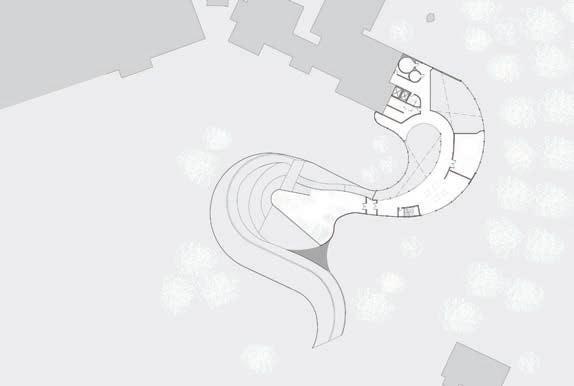

The name Mukwa Waakaa’igan “Bear’s Den,” in Anishinaabemowin was given to this building through spiritual Ceremony, prior to the design competition. To the seven Anishinaabe clans, Mukwa, the Bear, is a medicine carrier, protector, and healer of mind, body and spirit. “The building emerges from the land and rises up above Shingwauk Hall, evoking Mukwa’s profile,” the design team explains. “Visitors can stand high, as if on Mukwa’s shoulders, supported and given a new perspective to be above the pain of the residential school, looking down with empowerment.”


Other guiding principles drawn from Indigenous teachings find expression in the building’s form and orientation. Points of entry and space planning take cues from the Medicine Wheel’s four cardinal directions and its three additional sacred directions (up, down, and centre). The intertwined strands of a sweet grass braid inspired a circulation system of three pathways, each connecting the building to its landscape: Past, honouring the experiences and hardships of the children of the residential school; Present, attaining a perspective of empowerment; and Future, exploring and sharing indoor and outdoor cultural learning spaces that can lead Algoma University’s Indigenous and non-Indigenous community members toward a more sustainable future.
Constructed from locally sourced mass timber, Mukwa Waakaa’igan will nestle into the landscape and invite people to ascend the paths leading to its topmost green roof promontory. In addition to ceremonial and gathering spaces and a garden for Indigenous foods and medicines,
the centre’s outdoor spaces include forest, dry and wet meadow, and riparian landscapes, all of which will be planted to mitigate the effects of invasive species and stimulate the recurrence of native species. Through its integration with the landscape, Mukwa Waakaa’igan blurs boundaries between indoor and outdoor space. On pathways through the site, visitors encounter monuments that prompt reflection on the residential school era, and natural settings that may stimulate thought about our place on this planet now, and moving forward.



“Simplicity is very difficult to achieve. This project has a delightfully simple air to it that provides a nuanced and subtle reference to traditional morphology for this ceremonial building, and avoids the pitfalls of colonial representation. The very thoughtful use of pattern, repetitive structural elements, and a clever balance of structural systems creates a shelter that hovers over the Prairie landscape awaiting the celebrations of deep-rooted traditions on the lands. The physical connection to the land is appropriately light and ephemeral. The project will be delightful in a state of celebration, and also in the state of quietness between powwows.”

– Peter Hargraves, juror




Drum groups and dancers often spend their summers on the powwow trail, making cross-country treks to compete for titles, share songs, dance, and revitalize traditional ways while engaging with community members from across many First Nations.
Muscowpetung Salteaux Nation is based on a Qu’Appelle Valley reserve, approximately 70 km northeast of Regina. The design of








the Muscowpetung Powwow Arbour draws inspiration from Indigenous building traditions, including the demountable structures that First Nations of the Great Plains carried with them as they followed the buffalo. Although the arbour is a permanent building, like a teepee it makes efficient use of materials that are lightweight, locally sourced, and readily available. It uses local timber and a system of cables that, the design team explains, “works like the stored energy of a drawn bow-string and the tensioning elements of drum heads.”
Developed in consultation with community and band leadership, the arbour’s design also considers and capitalizes on present-day local knowledge, labour and materials. Its lightweight system of spanning components avoids bending moments, and allows for onsite assembly by the local community. It is envisioned that the community will harvest pine and spruce poles from the bush; these poles will be cut to length and debarked on site, ensuring precise dimensionality and eliminating the need to outsource. Local metal fabricators who would

normally fashion parts for farm machinery could be employed to fabricate the metal connectors.
The circle has great symbolic significance in many Indigenous cultures, and the arbour’s structural system requires a circular geometry to balance its loads. The arbour is to be erected on a field planted with shadetolerant grasses; this vegetation provides the dance surface within the perimeter drum circle. The structure is oriented to the four cardinal directions, with Grand Entry from the east.

Open to the sky at its centre and constructed in concentric rings with some vertical separation between them for light penetration and ventilation the wide, conical roof hovers above the plain. Around the perimeter, slender, teepee-style log tripods support the canopy and the stands.

The roof’s design incorporates rainwater harvesting techniques and
renewable energy technologies that offer significant benefits to the community. Precipitation harvested from the 4,900-square-metre roof surface will irrigate an adjacent medicine garden and orchard. As well, the roof is designed to accommodate photovoltaic panels capable of generating 378,000 kW h per year enough to meet approximately half the energy needs of all houses on Muscowpetung Saulteaux Nation land.






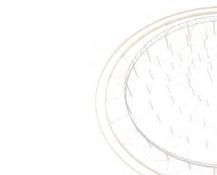







“Simplicity, harmony and beauty. A rich diversity of spaces both for the public and for art are woven amongst a fabric of existing buildings. The museum neither overwhelms the context, nor does it defer to it, but creates a new world of occupation in the neighbourhood. The reuse of the existing fabric buildings is economical, sustainable and creates a rich juxtaposition for the modern intervention.” – Betsy Williamson, juror
In 2021, Montreal’s multidisciplinary contemporary arts hub PHI launched an international competition for the design of PHI Contemporary, its new home. Located in the Old Montreal historic district, the site comprises four heritage buildings most conspicuously Maison Louis-Viger (c. 1765) and Maison Du Calvet (c. 1770) and a vacant lot. The winning design, by Berlin-based Kuehn Malvezzi and Montreal-based firms Pelletier de Fontenay and Jodoin Lamarre Pratte architectes, integrates old and new, indoors and out, with an emphasis on giving artists open, unencumbered space to bounce their ideas off of, and making the results readily accessible to the public. “Instead of proposing a new building, we are proposing a new infrastructure, where a variety of events can take place,” the design team states. “Artists need to take possession of all the spaces in surprising and unexpected ways. In this spirit of appropriation, no space should be off limits.”
The design layers a roof garden-topped platform onto the sloping site and extends two levels below grade. From Rue Bonsecours, the platform the level on which much of the exhibition space is concentrated reads as a simple glazed band that slots in behind the Maison LouisViger façade and connects to the second storey of Maison Du Calvet. Perpendicular to Rue Bonsecours, a wide void extends through the site from north to south; the void begins at the gutted Maison Louis-Viger interior and traces the width of the house through the platform. (Interiors of both houses had been altered extensively and often over the centuries, and there were condition issues. The design team chose to pare these stone structures back to their shells to highlight their original construction, while also creating as much flexible gallery space as possible.)
Multiple points of entry connect to a thoughtfully conceived circulation system. At the platform level’s southwest corner, an entrance through a new courtyard provides direct access through the building to the rooftop, via a ramp. At the core of all three main floors, a linear gallery transects the north/south void. The cruciform circulation system maximizes exhibition space and helps visitors intuitively grasp PHI Contemporary’s spatial organization. The partially unroofed “open field” section of the top floor’s circulation system blurs boundaries between indoors and out and opens up views between levels. Below the


platform, entries provide access to a semi-basement level containing reception, a café/bar, auditoriums, and archives.

The roof garden promises to be a new landmark destination in Montreal’s signature historic district. Upper portions of Maison Viger and Maison Du Calvet emerge from PHI Contemporary’s rooftop plane as though extruded through it. The crystalline forms of a new winter garden greenhouse and studio spaces add to the impression of the roof garden as an elevated arts playground that beckons passers-by to come up and view the old streetscape from fresh perspectives.

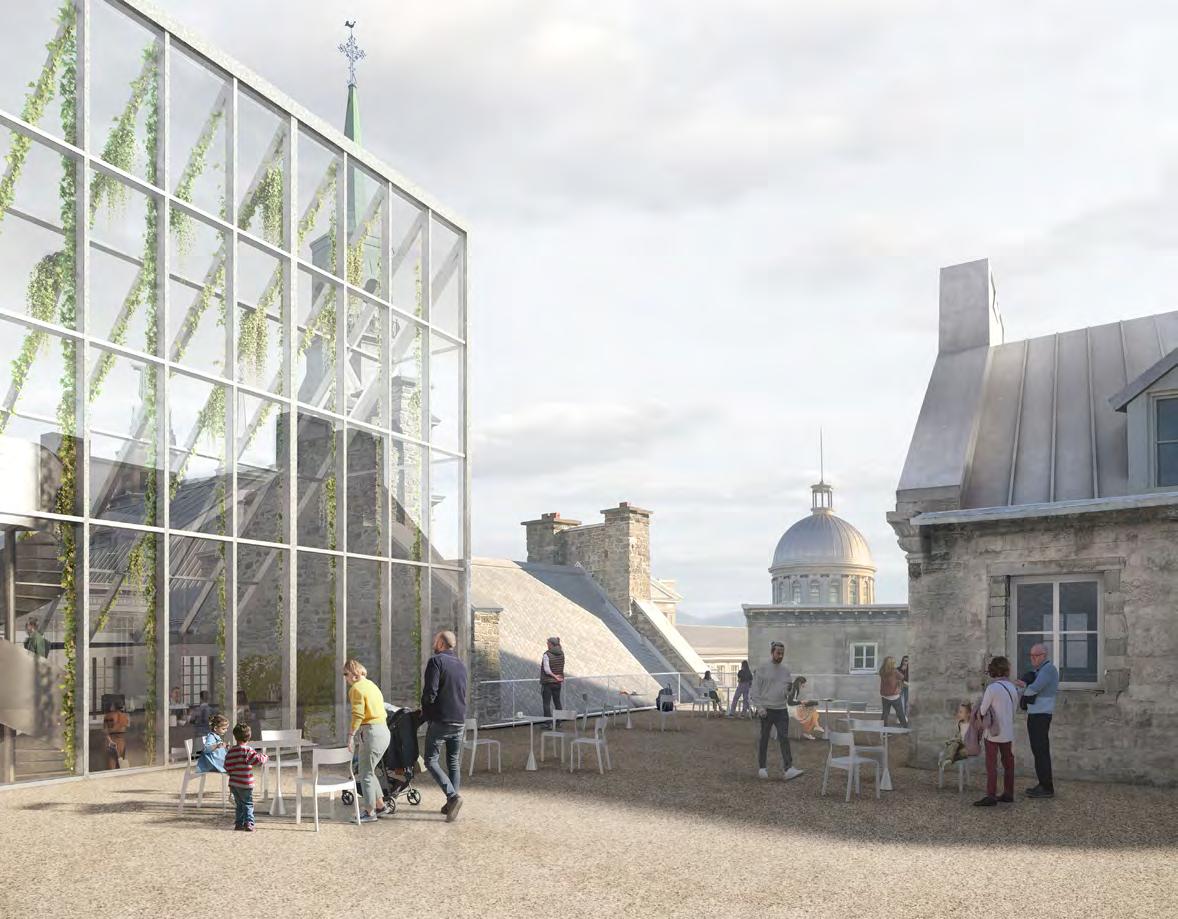
TOP A dozen studios for craftspeople occupy the shell of Locoshops, a decommissioned industrial structure. ABOVE LEFT The space is part of Angus Shops, a railcar manufacturing and repair facility built in 1904.


ABOVE RIGHT The studio windows create a playful composition against the openings in the freestanding brick wall. OPPOSITE The twelve lightweight studios create the backdrop for a new public gathering space, framed by open steel trusses above.

“This project represents a simple adoration of a by-gone era with an appropriate level of adornment. The syncopation of the fenestration in the intervention pays recognition to the past, referencing the old brick façade, and yet the project still manages a degree of autonomy, important for a hopeful and different future. The simplicity of the project, including the understated furnishings and interior detail, are appropriate: they do not betray the history of the place, yet offer a level of finesse fitting for the intended users of the Ateliers. Delightful without kitsch.” – Peter Hargraves, juror

Located inside the brick-and-steel shell of the Locoshop Building’s southern portion, Les Ateliers Angus offers an imaginative transformation of a decommissioned industrial site in Montreal.
The Angus Shops complex, once part of the railway network originally run by Canadian Pacific Railway, consists of several buildings used for manufacturing train components. This includes the Locoshop Building, an industrial shed that has since been converted into studios, offices, and stores. The linearity and rhythmic nature of the railway operations inspired the addition of a project running parallel to the historic façade’s massive brick wall.
Les Ateliers Angus is a series of craft studios, made of twelve lightweight units assembled in a continuous strip. In keeping with the historic use of the site, the project accommodates light-industrial uses by professional artisans, from cabinetmakers to potters. The studios front a large, open-air hall, activating it as a public space.

Each 56-square-metre unit includes a semi-public space on the ground floor for exhibitions, paired with a private mezzanine loft. A large, operable skylight brings in diffuse daylight and allows for natural ventilation. Units can be combined to maximize flexibility for occupants. Facing the public hall, floor-to-ceiling glazing transforms the studios into a series of tableaux vivants, showcasing the activities within and inviting a spontaneous theatricality.


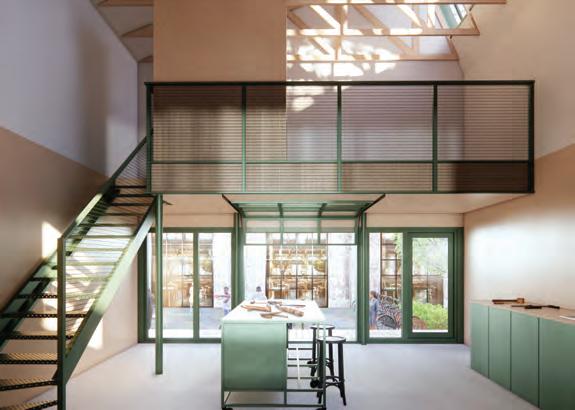
The proposal includes the conversion of the existing parking area, facing the new Ateliers, into public space. The new workshops will be built alongside the freestanding brick wall; from the south, views are framed by the façades of both the existing and new structures. The space in-between new and old will be animated by people coming and going.
As the interior programming establishes itself, the project will evolve into a new cultural destination. The commercial spaces, workshops, open-air events and exhibition areas will create a strong sense of place, informed by the distinct history of this Montreal neighbourhood. The texture, materiality and strong geometric lines of the addition yield a fresh but grounded take on Angus Shops’ rich industrial heritage.



“The project proposes a well-designed urban solution to the housing problem. The vibrant mix of forms and uses would create a strong community feeling. Bringing back the traditional Montreal alley as a pedestrian space is a strong solution, tying together the different parts and providing a playful environment. The relatively low-volume massing should help with sun penetration and mitigate wind.” – Louis Lemay, juror Montreal’s Mercier-Hochelaga-Maisonneuve borough is about to become a lot more populous. On multiple mega-blocks in the shadow of the former Olympic Stadium’s looming, leaning mast a constant reminder of the dangers of thinking big without thinking things through several major residential/mixed-use redevelopments are underway.
One of these, Canoë by developer Rachel Julien, designed by Aedifica and ADHOC architectes, comprises approximately 650 condominium units, 200 rental units and 158 social housing units, in tandem with at least 5,600 square metres of retail space. Its mix includes 20% community housing, 20% rental housing and a wide range of familycentric affordable housing units. The Canoë team’s two main strategies for thinking smart while thinking big are inclusive, pedestrian-priority
urbanism and a holistic approach to a new neighbourhood’s resource management and energy consumption.

Residential buildings of three to twelve storeys are organized around Canoë’s Allée des Artistes, a pedestrian street that slices through the site on a diagonal. Amenities directly bordering this promenade include multiple art galleries and an artists’ workshop, six playgrounds, a grocery store, a gym, multi-purpose space, and co-working space. Other on-site features are a pharmacy, a day care and several coffee shops.
Along one edge of Canoë’s site, 10% of the land will be developed as a linear park. Multiple courtyards and green roofs provide additional respite in a development that will concentrate a large supply of new housing units near two metro stations. A variety of circulation routes helps ensure that multiple speeds and modes of travel on foot, on a bike, in a car can be integrated safely and harmoniously.
The varying heights and diverse footprints of Canoë’s buildings are a starting point for endowing an entirely new development with some of the variety of a cityscape that has evolved over time. Along l’Allée des Artistes, façades are bevelled at the street edges to reduce massing and shading; varying this faceting from one building to the next adds


animation to this activity-oriented corridor. Meanwhile, the materiality acknowledges that facing a street is a very different condition from facing a courtyard. The “public” façades will have mineral and masonry cladding that complements the colour and materials palette of the surrounding blocks. On courtyard-oriented façades, a light metal cladding will help compensate for more limited exposure to natural light.



The developer has partnered with Énergir to integrate renewable energy sources and thermal energy redistribution initiatives into an infrastructural loop that targets a 60% reduction in energy consumption and at minimum an 80% reduction in greenhouse gas emissions, compared with conventional developments. In addition to increasingly common technologies such as a geothermal system and the preheating and pre -
cooling of ventilated air, sustainability strategies include heat recovery from grey water, recovering remaining energy from electric vehicles via reversible terminals, and even collecting energy generated by humans exercising on gym equipment such as stationary bikes. As well, members of Canoë’s community will have opportunities to grow some of their own food and support a beekeeping program.

The school in Colorado Springs, Colo., needed an update because codes, technologies and building materials changed over the years. There was no applicable standard for testing or maintenance on the existing smoke vents, which opened with a complex system of ropes and pulleys.
School officials also expressed concern with the vents, which lacked insulation and allowed noise infiltration that interfered with school events. The school’s auditorium is located directly underneath the vents. The existing vents remained in place and were sealed and insulated to improve energy efficiency and acoustics.
• Palmer High School, which was built with support from the Works Projects Administration in 1940, needed new smoke vents installed on the roof.
• The existing vents were loose, uninsulated and did not have a UL listing. They were also installed in vertical walls of a pop-up, cast-in-place concrete structure on the roof of the school.

• 4 BILCO acoustical smoke vents installed atop the school prevent noise infiltration and support firefighters by allowing smoke and gases to escape in case of a fire. The vents include burglar bars to prevent unauthorized entry.

• Acoustical smoke vents are frequently installed at theaters, concert halls and other applications that require limiting noise from external sources.
"Even weather, such as hail, can be loud. We wanted to make sure during performances we could mitigate exterior noise. We like the BILCO products. They seem to be the one that we see on most of our projects.”
– Frank Kaiser, Architect, LKA Partners
Experience. Innovation.
“With poetry as its inspiration, the rhythm of structure and light envelops spaces that enrich and celebrate the history and soul of the community. Housing a diverse and changing program over multiple floors, this sustainable building becomes a place of learning and exploration while promoting the importance of light, health and wellness through its architecture.” – Betsy Williamson, juror
“You must inhabit the space where you find yourself, with its faces and its landscapes, its particular rhythms, and the ancient dream of transplantation, because man is a tree that walks.” – Dany Laferrière, Haitian-Canadian author
The Bibliothèque et Centre culturel du Coeur-Nomade is a newgeneration library and cultural centre that will showcase the largest collection of Caribbean and Afro-Canadian literature in North America. Referring to a story by celebrated Haitian-Canadian author Dany Laferrière, the name Coeur-Nomade evokes a place of passage where
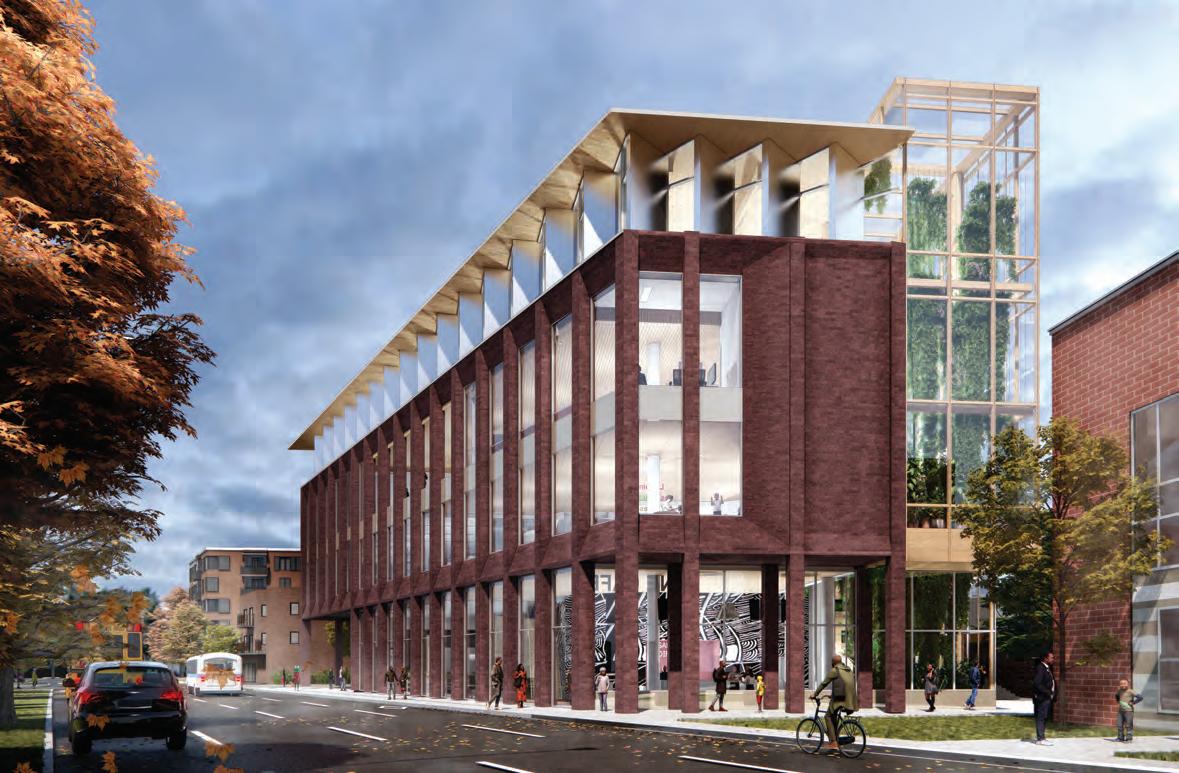
people of diverse backgrounds converge. Laferrière and Quebec poet Pierre Nepveu served as inspirations throughout the design process.
Montreal North is one of the poorest urban districts in Canada. More than half of the population identifies with a visible minority and immigrants from Haiti, the Maghreb, and Latin America make up more than 40 per cent of residents.
Current political discourse in Quebec suffers from a stagnant debate between multiculturalism and nationalism. Pierre Nepveu has imagined a third way a type of altruistic pluralism that celebrates, as he writes, ‘’the capacity of poetry to support the profound nature of democratic citizenship’’ and that posits the inclusion of difference as the fundamental role of democracy. The design team avidly debated the issue of cultural appropriation: what does it mean for a group of privileged architects to design a cultural centre for a community with considerably less agency?
Before it congealed into a recognizable aesthetic in the 1960s and 70s, Brutalism had a social mission. Coeur-Nomade revisits both the


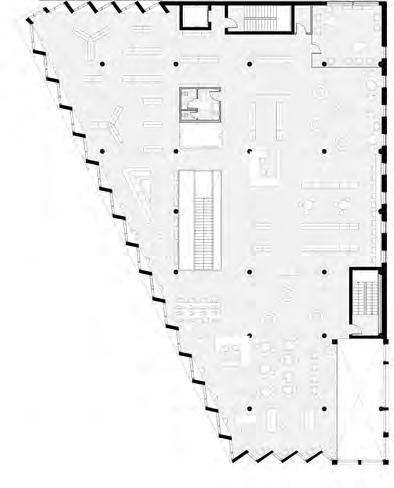
social and formal dimensions of Brutalism and updates this vision with Pierre Nepveu’s idea of geographic proximity as a generator of identity. Harnessing Brutalism’s basic tenet of collaborating with end-users at an intensely local level, the architects assembled a project team rooted in the literary and artistic community of Montreal North.
Facing the city with assurance, the urban shell of Coeur-Nomade protects a flexible, intimate, and brightly lit interior. At once an energy-efficient envelope, an acknowledgement of historic Montreal architecture and a nod to the Brutalist aesthetic, this front elevation is a key element of the building’s image. Evoking the animistic spirituality generated by Dany Laferrière’s weaving together of earth, trees, and mankind, a dynamic colonnade barely touches the sidewalk. Perched on elegant legs, CoeurNomade appears ready to travel the world. The library is a tree that walks.
Coeur-Nomade is designed so that the citizens of Montreal North recognize themselves in their library. The welcome begins with an invit-

ing layout that recalls familiar places, such as the lush tropical vegeta tion of the winter garden, public spaces defined by earthy colours, and abundant natural light. The program is organized by a simple stack ing of functions that fills the complete zoning envelope. The public moves between floors following an artistic circuit anchored by a mural in the entry hall, and segueing into thematic sections for digital arts, African sculpture, and Nordicity, as well as display cases for the Caribbean and Afro-Canadian collection.








“A modest building that defies the simplicity of its expression with rigorous sectional development. The sinuous flow of spaces allows the building to work both as an art museum and as a hub for the community, blending the abstraction of the volumes with the richness of the forest. The quiet and controlled palette of natural materials nods to minimalism, while anticipating the patina that will begin to merge the building with its surroundings.” – Betsy Williamson, juror
Hornby Island lies off the coast of central Vancouver Island, on the unceded territories of the K’ómoks First Nation and Pentlatch Peoples. Its 30 square kilometres of forest, slate beaches, and sandstone beaches have made it a longstanding pilgrimage site for artists, potters, architects, and back-to-the-landers. Its unique building culture is rooted in a “peasant palette” of inexpensive local materials and hand-trowelled stucco over stacked split firewood logs. For over 20 years, the Hornby
Island Arts Council has been fundraising for a new building to bring cultural programming under one roof for this community of 1,200 permanent residents and 5,000 summer residents.
The Hornby Island Arts Centre is sited on a plateau in a small forest clearing, a space already used for music events and poetry readings. Surrounded by fir trees but still visible from the main road, the new building will attract visitors and locals alike. Originally envisioned as an art gallery, the Centre has evolved to encompass a broader reach within the community. As the first new public building on the island in nearly 40 years, it must offer something to everyone. It will operate as a gathering space: a place to host movie nights, dances, art shows, yoga classes, potlucks, performances, lectures, and more.
To do so, the Centre is an agglomeration of interior spaces with varying spatial and light qualities. During the day, its rough white stucco will shimmer in the forest, while at night, the warm glow from


its interior lighting will filter through the trees, illuminating the paths that wind around the building. The cladding is made of 3.7-metre-tall fence posts that wrap around the floating roof’s soft corners, turning inward and narrowing to draw attention to the large wooden pivot door of the main entrance.

The roof’s prefabricated trusses are sized to fit on the small ferry that services the island. In the gallery, these trusses are curved to accommodate a large south-facing clerestory window. Operable windows allow the space to be naturally cooled.
CLIENT 8 9 7
WATSON ELECTRICAL 2 1 12
HORNBY ISLAND ARTS COUNCIL ARCHITECT TEAM D’ARCY JONES (MRAIC, DESIGN LEAD), JONNY LEGER (PROJECT LEAD), SHANE HAUSER (RENDERINGS), DEREK KRASNODEMBSKI (RENDERINGS), LUIS YANEZ HERNANDEZ (SITE MODEL), MELODY CHEN (PLASTER MODEL) | STRUCTURAL WICKE HERFST MAVER STRUCTURAL ENGINEERS—DAN WICKE, THOMAS 5 4

VAN WERMESKERKEN | MECHANICAL AME CONSULTING GROUP—CASSIDY TAYLOR, 3
ENGINEERING 11 10 6 8 6 j v `j jv `v `jv h
MCAULEY CONSULTING—TAVIS
SKINNER



Montreal, Quebec
KPMB Architects + Daoust Lestage Lizotte Stecker Architecture“The project is about reconciliation more than celebrating pain. It is remarkable at different levels. The choice of the location in the heart of what was once the Jewish community is appropriate. The volumes interpret the heritage of St. Laurent Boulevard by modulating the massing, and the project democratizes the museum functions by opening the building to the street. The outdoor landscaped garden is a fine solution to provide natural light, vegetation and quietness. The transparency and the subtle play of natural light enhance the quality of the interior spaces and the visitor’s experience.” – Louis Lemay, juror
Founded in 1979, the Montreal Holocaust Museum launched an international design competition in 2021 for a purpose-built home. The site, on St. Laurent Boulevard (“The Main”) is in the heart of what was Montreal’s largest Jewish immigrant community in the first half of the 20th century and where many successive newcomer populations have since put down Canadian roots. The new museum bears witness to the Holocaust and the nearly 10,000 Holocaust survivors who found refuge in Montreal shortly after the Second World War. It also recalls the massing of the old storefronts and walk-ups that lined St. Laurent Boulevard in the decades when the area was the city’s Jewish Quarter.

Several narrow buildings typical in their massing for this neighbourhood previously occupied the site. The former lot lines are expressed as narrow, glazed and skylit voids incised through the museum, from St. Laurent Boulevard to the south to St. Dominique Street to the north. The museum is highly transparent at grade along St. Laurent, with views through an open reception area, named the Agora, to a courtyard garden planted with birch trees, and into the museum’s bookstore, café, and multipurpose room. In contrast with the clearly public ground floor, the galleries on the upper two floors are inward-focused spaces: closed off from the street and clad in grey Quebec limestone, they quietly direct attention to the artifacts and information panels they contain, while also offering courtyard and rooftop garden views as a respite.
Near the main entrance, an external forecourt is framed by the Wall of Memory, a major organizing element that extends through the ground floor in successive sections, passing through indoor and outdoor spaces. Inscribed into the wall are quotations and the names of annihilated Jewish communities. Another section of the Wall of Memory divides the garden courtyard from an interior commemoration space that faces toward a smaller courtyard containing a solitary birch tree, emerging from a water mirror. Narrow ledges on the Memory Wall’s commemora-


tion space side offer places where museum-goers can place small stones, the customary token of remembrance left by visitors to Jewish gravesites.
Central to the museum’s design is the concept of nature as a counterbalance to horror. In addition to the garden views encountered throughout the building, the narrow lot-line voids, with their transparent flooring insets aligned below roof-level skylights, bring shafts of natural light into the building that wax and wane in accordance with the weather and time of day.
A combination of structural steel framing and simple rectilinear volumes helps ensure that this project’s schedule and budgetary constraints can be met. It also maximizes the openness of the ground floor: suspending the volumes above the agora from trusses makes possible an expansive,


column-free reception area that invites visitors into the museum. “The Museum must be a welcoming, inclusive space that speaks to resilience and hope,” the design team states, “even while addressing one of our darkest histories, a catalyst for change and for social justice.”
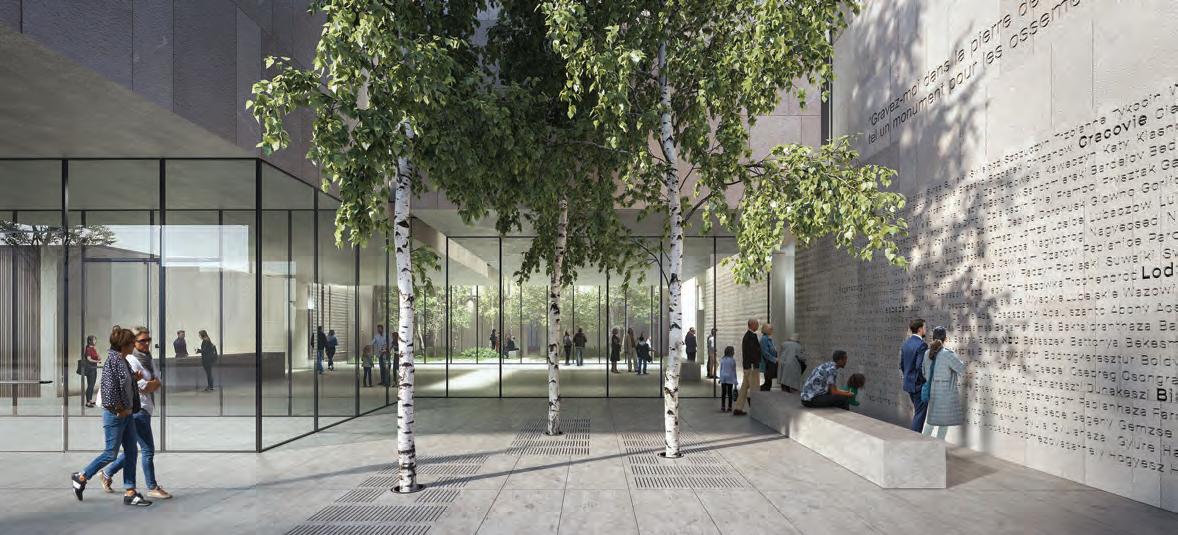
Our unique calcium silicate brick products feature a natural, fine-grained appearance. Our distinctive, long format Architectural Linear Series Brick combines sleek, modern lines with a rugged, weathered finish. Incredibly stylish, our Architectural Linear Series Brick comes in a selection of designer colours.


 ARCHITECTURAL LINEAR SERIES BRICK
ALSB Custom Colour
The Soto
Architect: Lake Flato / BOKA Powell
ALSB Custom Colour
ARCHITECTURAL LINEAR SERIES BRICK
ALSB Custom Colour
The Soto
Architect: Lake Flato / BOKA Powell
ALSB Custom Colour
 Toronto, Ontario EDGZ A&D
Toronto, Ontario EDGZ A&D
“This exploration of a housing typology is an excellent response to issues of climate change, life-work balance, housing security, urban form, and inflation. The design ambition of addressing these issues with a response that is sublime is ambitious. Especially notable are the scale of the project, the interplay of materials in the façade treatment, the careful planning on a small site with options for a variety of unit designs, and the careful design of the building section to use light and material within the building. All work together to establish a sanctuary of calm, away from the loud world beyond the highly insulated shell of the duplex.”
– Peter Hargraves, jurorPassiv(doppler)haus in Search of the Sublime is a duplex designed to evoke the concepts of sanctuary and resilience by harnessing the calming character of Zen and the awe-inspiring essence of the Sublime.
The property is located in Toronto’s Riverside neighbourhood, on a street with mature trees and a variety of low-rise housing, from Confederation-era bungalows to three-storey contemporary town-
homes. The site originally contained an 1860s cottage-style bungalow near the end of its lifespan. The wedge-shaped massing of the new building responds to zoning requirements and site context, reflecting the different heights of the neighbouring homes.
The concept of the Sublime is invoked through the home’s sense of mystery and depth. One steps into a grounded entryway of earthy materials, such as clay tile and artisanal plaster. The subdued light proceeds to brighten upwards as light flows from a central skylight. The striated and interlocked forms speak to the multi-unit typology common in the neighbourhood, and clearly articulated in the bifurcated façade of this duplex. The materiality of the lower and upper units also establishes the tonal, earthy palette. A brick base speaks to Toronto’s historic building vernacular, while the upper unit is clad with 2x2 vertical wood slats, thermo-treated and fire-resistant, distinguishing it from its lower neighbour and providing a sense of warmth to the façade.
This home is designed to be Passive House Certified. The windows and skylights are triple- or quadruple-glazed, and the roof angle has been
THE DESIGN METHODOLOGY IS CENTERED ON A COMPREHENSIVE SYSTEMS APPROACH TO MODELLING, DESIGN, AND CONSTRUCTION. THE OPERATIONAL ENERGY EMISSIONS ARE REDUCED BY UP TO 90% COMPARED WITH CONVENTIONAL CODE MINIMUM HOUSES THROUGH THE INTEGRATION OF AN AIRTIGHT ENVELOPE, EXTRA-THICK INSULATION, MINIMAL THERMAL BRIDGES, TRIPLE-GLAZED PASSIVE HOUSE CERTIFIED WINDOWS AND DOORS, AND A BALANCED AND CONTROLLED VENTILATION SYSTEM WITH HIGH-QUALITY HEATING AND COOLING EXCHANGE. SOLAR PANELS ALLOW THE HOME TO ACHIEVE NET ZERO. EMBODIED CARBON IS PRIORITIZED THROUGH THE CHOICE OF MATERIALS SUCH AS LESS FOAM-BASED INSULATION AND NO SPRAYFOAM, WOOD STRUCTURE INSTEAD OF STEEL, AND MORE LOCAL OR RECYCLED MATERIALS. ADDITIONAL BENEFITS TO THE HOMEOWNERS INCLUDE A HEALTHY ENVIRONMENT, WITH SUPERIOR THERMAL COMFORT AND STABILITY AND EXCEPTIONAL INDOOR AIR QUALITY.
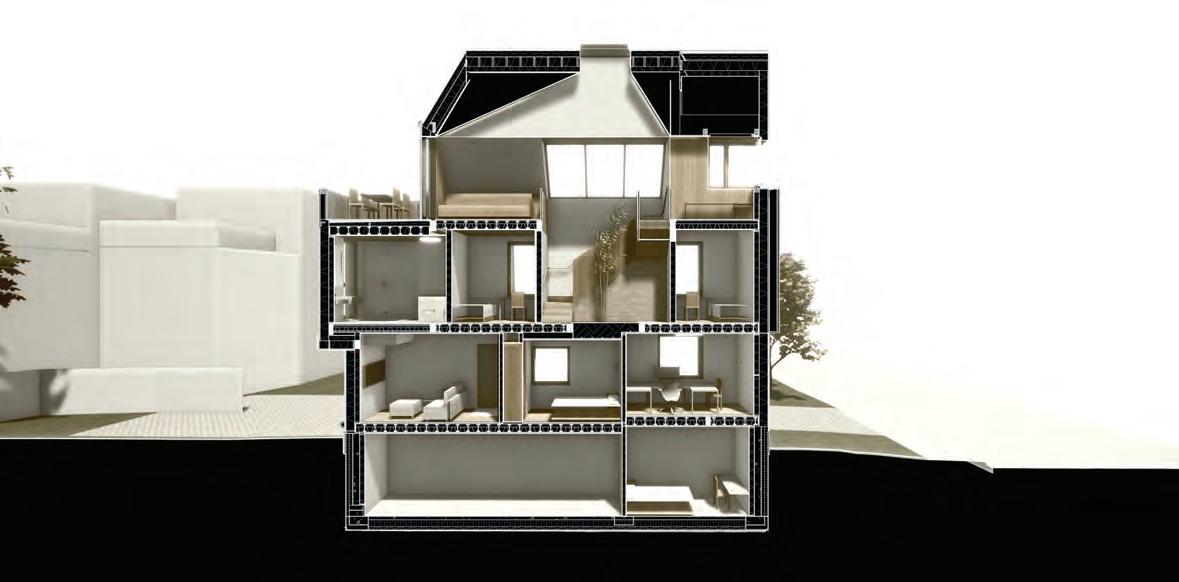
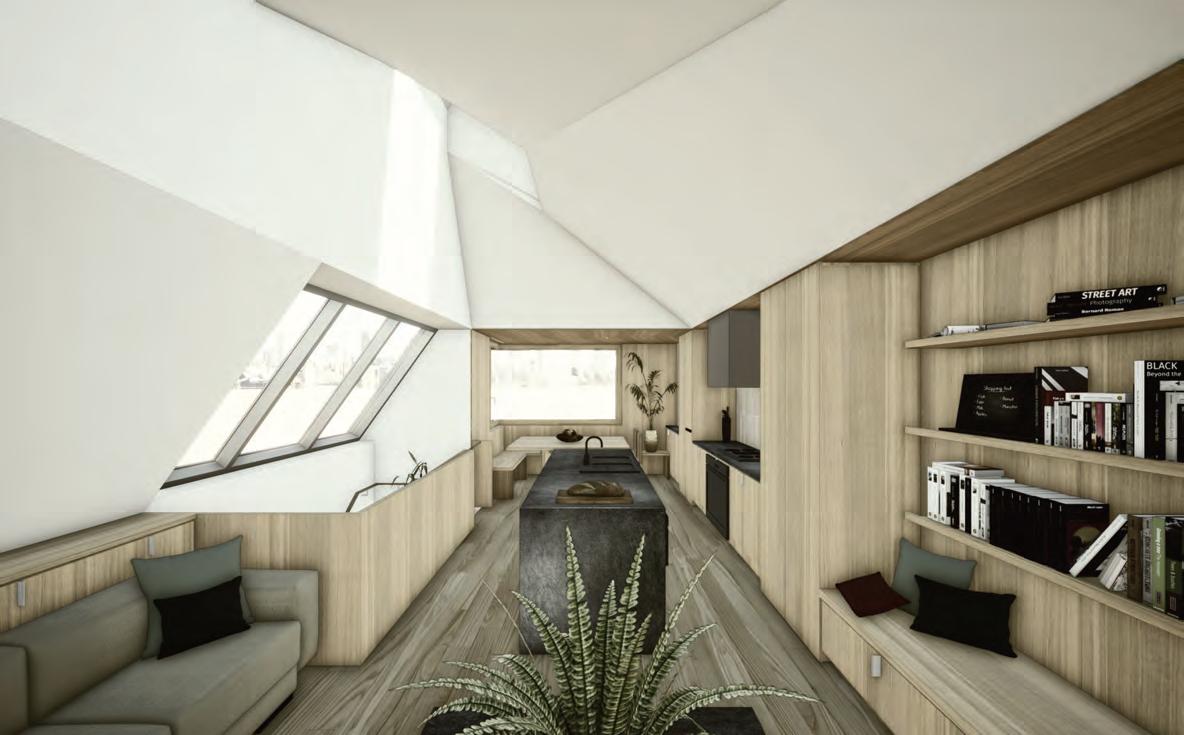
calibrated in accordance with a solar analysis of the ideal angle for photovoltaic panels. The operational energy emissions are substantially reduced through the integration of an airtight envelope, extra-thick insulation, minimal thermal bridges, Passive House-certified windows and doors, and a controlled ventilation system to provide effective heating and cooling.

The house is nestled close to its southern neighbour to allow for the possibility of a future driveway, limiting openings on the south façade. However, extra glazing for northern light is incorporated by sloping a large glass plane above the stairway angled just enough to count as a roof instead of a wall.




Introducing the roofing system that delivers 600 consecutive months – that’s 50 years – of unparalleled, environmentally friendly roof and insulation performance against the elements. Our new system is a collaboration between Duro-Last® and DuPont™, the two trusted leaders in commercial roofing and construction. Demand sustainability. Specify the roof that’s decades ahead of its time. Duro-Life™ 600 Roofing System.
“Duro-Last” and the “World’s Best Roof” are registered trademarks owned by Duro-Last Roofing, Inc. Duro-Life is a trademark owned by Duro-Last Roofing, Inc. DuPont™, the DuPont Oval Logo and Styrofoam™ Brand are trademarks of DuPont de Nemours, Inc. or its affiliates.
“The project is an interesting experiment in optimizing renewable resources, paired with a study of potential assembly systems. The idea of transforming and using different components of wood to create diverse kinds of enclosures is very appropriate to the generation of sustainable architecture.” – Louis Lemay, juror
Since the industrial revolution, Western building systems have relied on a static understanding of materials and a false sense of control. This often results in muted uniformity and a material system incompatible with the natural dynamic of the environment. What happens when we align our industrialized building paradigms more closely to the patterns of natural systems?
Herrling Island is the last undiked island within the Fraser River in British Columbia. This project invites the chaos and behaviour of natural systems to guide the design and construction process. By working with chaos, vulnerability, and improvisation, it aims to discover an architecture that is more flexible, active, and effective in addressing contemporary problems.
The large-scale clearcutting of Herrling Island’s native cottonwood forest has devastated the local ecosystem. This restoration proposition relies on both land-based and water-based interventions, with structures built with wood sourced from the black cottonwood trees already harvested from the island.
The interventions will be built with unrefined and non-standard components. Traditionally, cottonwood trees are not suitable for construction due to the wood’s tendency to warp and bend during the drying process. But the lumber can be rough cut and processed by hand in ways that respond to this wood’s unique characteristics.
A weir—the low barrier that controls the flow of water in rivers—has served in Indigenous culture to sustainably manage fish stocks; contemporary weirs are used to count the annual salmon run, assess the health of the stocks, and collect other scientific data. The weir proposed for this project blends historic Indigenous and contemporary western methodologies.
The weir also serves as a pedestrian bridge to the island. It is designed so that each spawning season, the main holding pens, platforms, and fishing fence will be rebuilt by the community and serve as a land-based learning activity.

To supplement the weir, a wet-lab structure will accommodate workers and visitors during spawning season. The removal of vegetation from the edge of the island channel has affected critical animal habitats, and compromised the island’s natural erosion resistance. To aid in their restoration, each layered component of the wet lab mirrors the functions of its natural counterpart. Instead of a structure that explicitly defines the boundaries of humans and nature, the architecture invites nature to reclaim its territory.
In response to the mass clearcutting that has damaged the island, dynamic netted tripod structures across the seasonally flooded area will nurture the vegetation and provide temporary habitat for young fish fry and birds.
The field lab acts as a home base for all land restoration efforts. The massing and articulation of the structure are inspired by lumber stacks and log cabins. The thickness of the lumber counteracts the unstable nature of cottonwood, stabilizing the structure without any fasteners. The elevated walkway creates a vantage point for mapping and surveying the land, especially during the flooding season. As the forest regrows, the walkway will allow visitors to stroll under the tree canopy.

ABOVE The weaving of a one-person, cubic room points to dynamic possibilities for shaping three dimensional spaces.


“The translation of material into space is a fundamental tool of architecture. Loom to Room works between digital models and craft. It pairs computational tools with ancient material practices that are literally mediated by the hand of the architect. It creates an unconventional tectonic language, using one material, through which to describe changing spaces, thresholds and openings.” – Betsy Williamson, juror
From Loom to Room investigates the spatial, conceptual, and performative possibilities of weaving in three dimensions and its potential integration within the built environment. It is a study of how to translate material into space, movement into form, and design into collaboration.
Historically, weaving has provided an occasion to gather generations together. It is a shared activity, traditionally done by women. Today, feminist scholarship recognizes the important role of these weavers
within our cultural history. The repetitive interlacing of thread to make fabric is a form-generating process, transforming time into material. This inspires the question: how does the action of “making” inform and respond to design intentions?
To understand the relevance of this gendered labour in architecture, Naomi Julien set off to weave an entire room. To accomplish this, she moved back and forth between digital and analog design processes. She began by using a rigid two-metre-wide maple cube as the frame, then scored all twelve edges of the cube equally on each side and chose a highly elastic synthetic blend for the thread. She connected edges together by transforming lines into surfaces, networks into patterns, and layers into obstacles.
Julien used parametric design to test possible thread intersections, and computational tools to script the logical sequence of the weave.
This sequence generated a weave that simulates bodily movement and transcends the loom itself. On further iterations, the warp and weft began to articulate a series of emerging openings, intersections, thresholds, and passages. Together, they challenge our preconceptions about spatial boundaries, agency in design, and materiality. Each thread expresses a negotiation between outside and inside, beauty and use, private and public, art and design.
While this research does not propose an alternative to rigid building structures, weaving of this type could subdivide interior spaces by creating semi-transparent partitions, or connect building façades with filamentary canopies. Weaving can promote the engagement of people with the built environment, where a form comes into existence as the embodiment of a rhythmic collective movement.

Jon Ackerley, University of British Columbia Advisor: Blair
Satterfield“The jury members were required to check their abhorrence at a future in which humans merely become cogs in a machine that grinds through product and waste in a cycle of existence that doesn’t result in much hope. This student clearly had the courage to explore a future, based on present trajectories, that point towards a dystopia which seems disagreeable from the perspective of the spirit of humanity. The work is evocative: subversive while remaining rigorous in the response to what this might all mean. The drawings and illustrations were complete and comprehensive, allowing for appropriate critique.” – Peter Hargraves, juror
The suburbs are made possible by sprawling systems of resource extraction, infrastructure, and shipping. The outputs of these systems are accumulated and assembled into recognizable symbols of suburban culture.
But the industrial roots of suburbia are obscured by the separation between industry and other suburban typologies. Landscapes of production and landscapes of consumption are kept culturally and physically distant. This is evident in Bowmanville, Ontario, where a large industrial waterfront is separated from the communities it supports and impacts by an infrastructural buffer zone.
This thesis proposes a new typology: a community that merges industry and domesticity, melding their iconography together and making industrial systems visible. Here, we can learn what it means to live with industry, through flattening landscapes of consumption and land-

scapes of production. The proposal, Subindustria, is a bio-mechanical community designed for a strip of land between the Bowmanville cement plant and Highway 401.


Subindustria’s residents live in superstructures, oriented around a central bio-materials factory. This facility processes hemp, mushroom and thatch grown in the surrounding community and transforms them into viable building materials, such as hempcrete and mycelium wall panels. The infrastructure and industrial systems that construct the houses become a direct extension of it, resulting in one continuous system that blurs industry and domesticity.
All of Subindustria is elevated. By raising it off the ground, it refuses to engage with zoning by-laws or land-use policy. This upward shift also opens up large swaths of land underneath to be claimed by nature,
enjoyed by the community, or used as productive agricultural land. Each superstructure module sits above a hemp field. It can roll aside to provide sunlight as needed, with a system of mirrors drawing in light throughout the day. Mushroom farms are located underneath the module’s street. People, resources and waste are transported to and from the module along a central spine, aligning flows of materials with flows of people.
The design of each house is a subversion of a typical Bowmanville home. Their unique character merges bio-materials, suburban construction, and the celebration of mechanical systems. Each house includes a series of flexible indoor-outdoor rooms and verandas, clad in mycelium panels. The project blurs the line between where houses end and the machine begins.
“There is an aura of mystery encompassing this image. The scene is very cinematic, with its characters in action, and the fog that gently envelops the whole space. Something seems about to happen! The building rises like a character too. And then, the balance between the colours is just perfect.” – Félix Michaud, juror
The Dory Shop in Lunenburg, Nova Scotia, was constructed in the late 1890s for storing fish and salt. The shop is now used to build dories wooden boats made to traditional Nova Scotian designs. This image is one of a series I made last year on behalf of architect Brian MacKay-Lyons. The language, craft and construction techniques of Nova Scotia’s vernacular architecture fish sheds, boat houses, farm barns and others have been a constant muse for the contemporary practice of the Mackay-Lyons Sweetapple studio.


“I like this idea of showing a building in a temporary state, an unfinished process. This image creates a mysterious and soothing atmosphere.”
– Félix Michaud, juror
I drove past this site many times before committing to document it. Each time I passed, I found myself drawn to the condition of a hard building covered by a soft blanket; it wasn’t until this day that the weather allowed me to make the frame that fit my imagined narrative. Within an image that could be reasonably interpreted as sad, or bland, or cold and lifeless, I enjoy the subtlety of the muted tones, the bright reflections off the snow, and the honesty of the frame.

“Very soothing, conducive to contemplation. The path leads us to a figure who also seems to be in a contemplative state. The eye is constantly redirected inward. It twirls around, like the butterflies, here and there. This structure is imposing, but seems so light at the same time.”
– Félix Michaud, juror
A visit to Montreal’s new Insectarium is an enchanting journey of discovery, where the line between built and natural space is intriguingly dissolved.

A labyrinth of immersive underground chambers experienced from an insect’s point of view leads to a grand tomb-like dome adorned with butterflies and bugs. The metamorphosis for the visitor ends in the grand Vivarium, pictured here.
The photograph is from a series I was commissioned to make by the project architects, Berlin’s Kuehn Malvezzi and Montreal’s Pelletier de Fontenay with Jodoin Lamarre Pratte.

1x1 Architecture, Waskesiu Beach House, Prince Albert National Park, Saskatchewan Lisa Stinner-Kun

“With this image, I feel like I’m watching a live work of art. The setting is magnificent. It creates a sense of harmony between the building and the nature in which it is embedded. Without really seeing the building, it seems obvious that the integration is successful.” – Félix Michaud, juror
This image comes from a series of photographs I took for 1x1 Architecture, a firm based in Winnipeg, Canada. They commissioned me to photograph a new beach house in Waskesiu, Saskatchewan, a quaint vacation town located in Prince Albert National Park. The building beautifully complements its wild, subdued surroundings.
Before the elk came into view, I was initially struck by the subtle way the architecture was framing the landscape. Standing there in-person felt like being in a gallery, looking at a moving landscape painting. After taking my first shots without the elk, I packed up and walked away to set up for another photograph. While under my dark cloth, I heard beachgoers getting excited about something. I looked up to find the elk sauntering through the water, and I immediately knew I had to rush back to the earlier location to catch them in the frame of the previous composition. Luckily, I had enough time to set up and wait for the elk to perfectly position themselves. Now, with the elk in the image, the architecture transforms into a kind of cinema, where we can appreciate not just the beautiful scene unfolding on the movie screen, but the experience of the theatre the architecture as well.
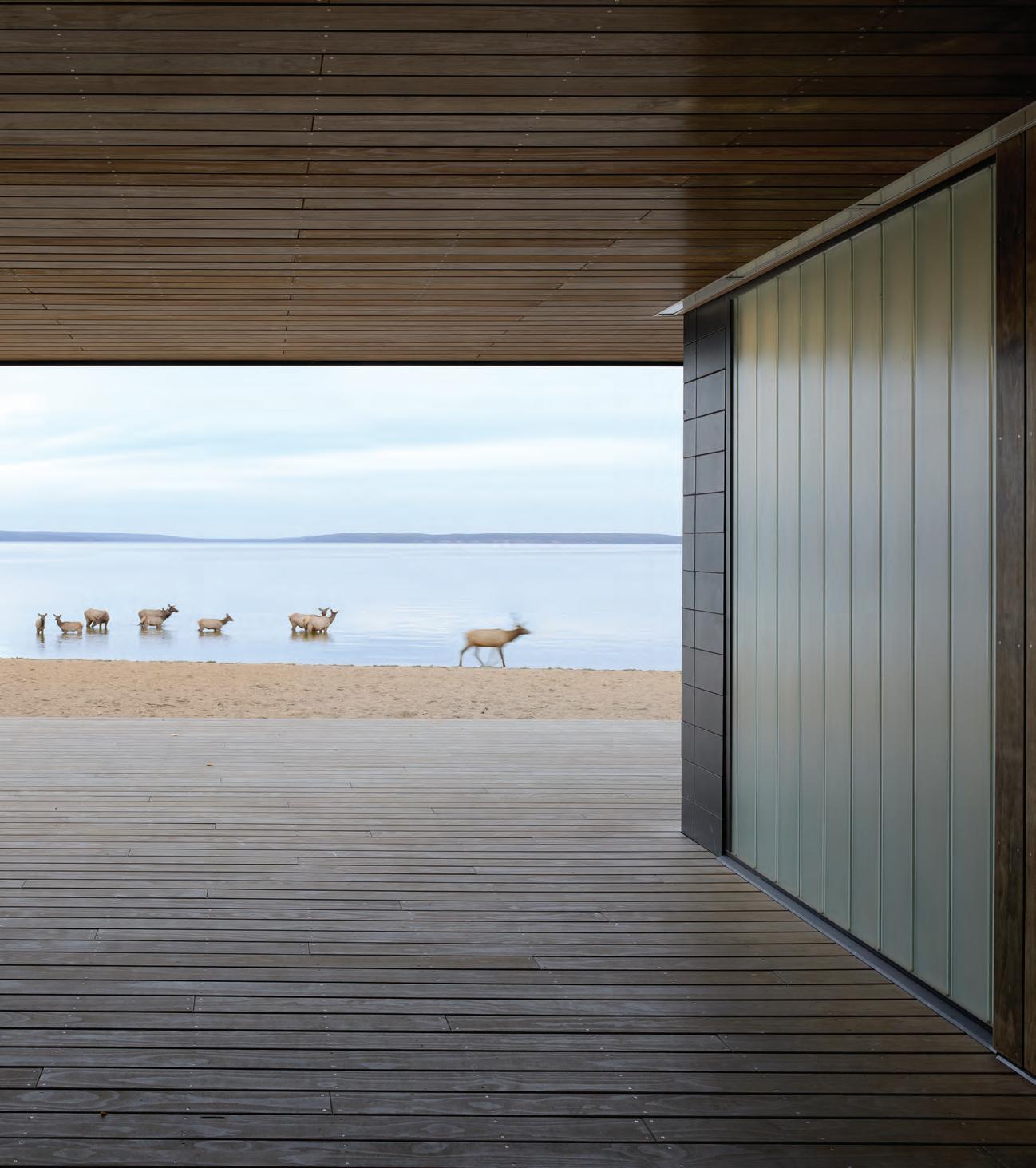


“Without entering the building, this shadow play allows us to discover part of the interior of this small construction while revealing the exterior beautifully. The quality of light is superb. A simple and effective photo, precisely like a tiny house, after all.” – Félix Michaud, juror

I met Ted at an outdoor neighbourhood gathering a few months before taking this photo, when a connection was made through a mutual appreciation of architecture. He and his wife Carolyn had

recently completed the construction of their home. I was invited over to see and potentially make images of their beautifully designed but yet unfinished outdoor hut, nestled on the riverbank and surrounded by trees.
While exploring the site, I looked up from my camera and noticed Ted fastening electrical cable to the wall with a hammer. Backlit by the golden-hour sun reflecting off the river, I framed this unplanned activity; an image of the builder and his muse.






NO, IT’S YOUR WASHROOM.


Whoever said the washroom (the most frequented room in any building) shouldn’t be as nice as the showroom? ASI just gave the washroom a makeover—you can too. Visit americanspecialties.com/showroom to explore the new standard for basis of design in washrooms. Featured in this ad are our exclusive Velare™ and Piatto™ collection of washroom accessories, ASI Alpaco™ partitions, and ASI lockers.






Summon your ultimate shower with a touch. With the intuitive design of digital controls, supreme power over water is now at your fingertips. Even Poseidon is impressed.

